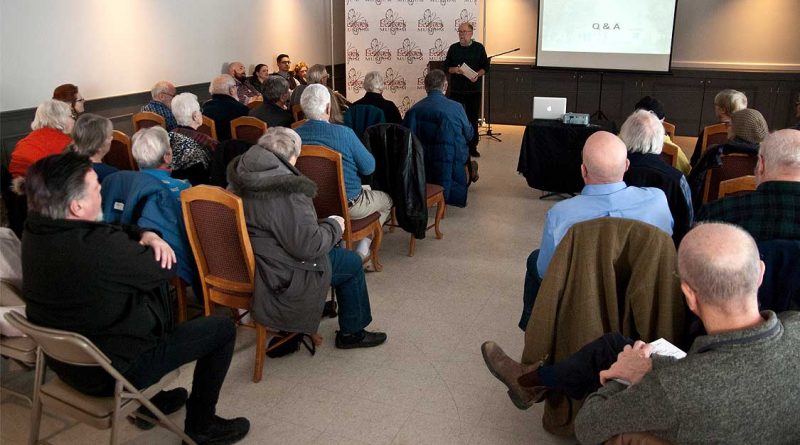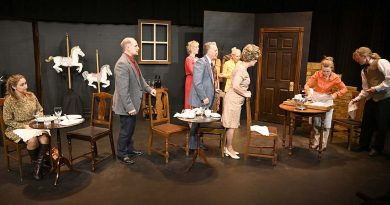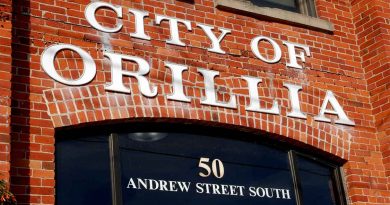This Week In Art/Culture/Entertainment
By John Swartz
This is a long one. Grab a coffee. It’s important, the coffee. When I say coffee, if it has a shot (of coffee) in it, better. The information’s good too I suppose.
Leacock is the most important person in Canadian literature history, there should be no dispute. Before Leacock there wasn’t Canadian literature, being part of the British Empire all the greats were English and Irish. OK, Scottish too. I suppose once translated Welsh as well.
He was also important as a political economist, his opinion found its way into government policy and some of his views are still operational today. But, it is the humour he is best known for, maybe. Maybe, is because he isn’t being taught in school anymore. He was on his way out when I was in elementary school. There are two generations of ordinary people who don’t know Leacock.
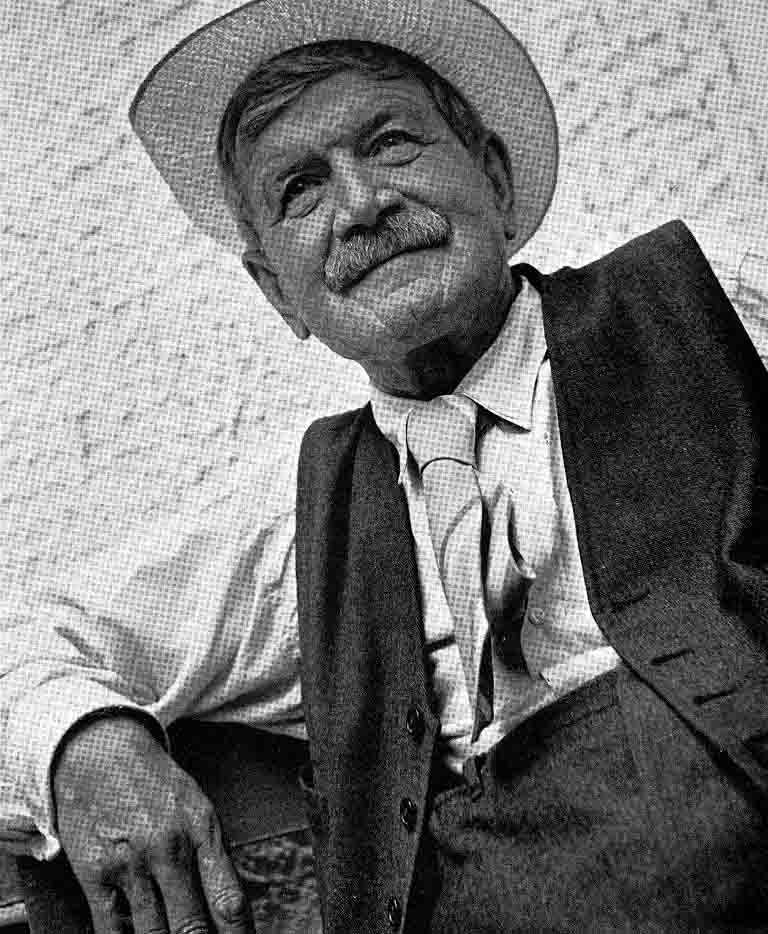
Somewhere I have a copy of what we used to call readers in the middle grades. I found it at one of the used book stores downtown and picked it up for a buck. I rediscovered the depth and complexity of the short stories we were made to read in Grade 4 or 5, or whatever it was; stories by W.O. Mitchell, O. Henry, and others. There are at least a couple by Stevie in it. I didn’t know a thing about him, or any of the others and we weren’t taught who the authors were (except for Henry and all we learned is he was the master of twist endings).
I zeroed in on the Leacock first the day I picked up that old book. One story was a chapter from Sunshine Sketches, and the other likely from Literary Lapses. I’d be more precise, but I can’t find the book. I don’t have the best filing system. On reflection it has occurred to me whenever I pick up Leacock to get away from the internet, it turns into a good day.
Sure he was funny. Not laugh out loud funny most of the time, but he presented humourous situations and milked them dry. Maybe because his most famous book is about my now home town is why I return to his work every now and then, but the quality of writing can’t be denied.
More important in the reading and many re-reads of Leacock, he, among a small group of others, showed me how to write. I am not the only one who learned to write by reading Leacock. There are many famous people who cite Leacock as an influence on how to tell a story, and, believe it or not, many regular folks who are of the same age, relatively, or older than me write well because they read Leacock.
I see it daily. Whatever they teach now about how to write isn’t working. Spend a day reading comments online from various websites, news, special interest, and particularly pages with a younger generation as the target audience. A large percentage of people cannot write even the simplest of messages. Those people obviously do have something to say, they just don’t know how to organize what it is they want to say in a logical and coherent way. Those who learned, against the odds, to write stand out like a new car in a junkyard.
I think it’s because they don’t read, they weren’t shown stories by great writers. I believe the more good writing you read, the better you become at communicating. Of course one has to practice writing too, but reading properly written material becomes a not so obvious guide of how to do it.
Most of our problems today are the result of shoddy thinking (which writing well makes a good antidote) and poor communication skills. Politicians can’t even construct a good attention diverting group of words and we all grimace when we hear or read them. The best example is the impeached individual-1 who reminds me of Grade 3 thinking and speaking, and there are others in government – politicians and administrators alike – and in business or any bureaucracy. What passes for deep thinking these days in the mainstream is pathetic, and if one searches out the truly smart and eloquent, Sam Harris being one, the late George Carlin another, you can’t help but see the contrast.
It is a great failure of our school system Leacock is not taught. There is hope and we in Orillia have the ability to do more than our part to save us from ourselves.
There Could Be A Plan
It is expected in March Orillia council will be presented with the result of the Leacock Museum Master Plan. As usual with reports prepared by consultants, a draft is run by the public and that happened last Thursday at Swanmore Hall.
Jon Linton of TCI Management Consultants represented the three firms (Reich and Petch Architects and Fisher Hospitality Group are the other two) who did the research and prepared the report.
The back story is, some councillors wanted a study either because they don’t want to be throwing any money at an entity they perceive as failing, or thought amalgamating the Leacock Museum with the Orillia Museum of Art and History would be a smart, money saving move – if it could be proved. Of course there are people in the community who don’t think we need museums, or libraries, maybe parks for that matter, who may have hoped the report would say sell it.
The report examined all aspects of the museum, particularly the ownership question and the management question among others. I’m focusing on those two aspects for the moment.
Generally they found there is a high regard in the community for the museum and of those who actually have been to the museum, but they also noted the museum and Leacock are also not the most recognized. I expected this. There has been a downturn for a number of years in turnout for events, and I’ve noticed at medal time the number of regional and national news organizations who report on it has dropped drastically.
They had a nice chart outlining a number of evaluation points for various kinds of ownership or management. The consultants came down squarely on the City retaining ownership.
Among the management options are keeping it with the City, turning it over to OMAH, turning it over to Parks Canada, finding a private operator, or setting up a non-profit operator.
Parks Canada came out the clear winner on all the counts, but Linton noted that option is unlikely because of Parks Canada’s focus on First Nations projects and their track record of assuming things they don’t own. I need to point out Parks Canada’s record on listening to the communities they operate in is not so good either, reference the Champlain Monument. I see no advantage, despite the finances, of turning over the museum to an organization making decisions from hundreds of miles away.
All the others had drawbacks except with the current situation proved to be no harm, but also no gain, and a merger with OMAH had a few positive and neutral effects.
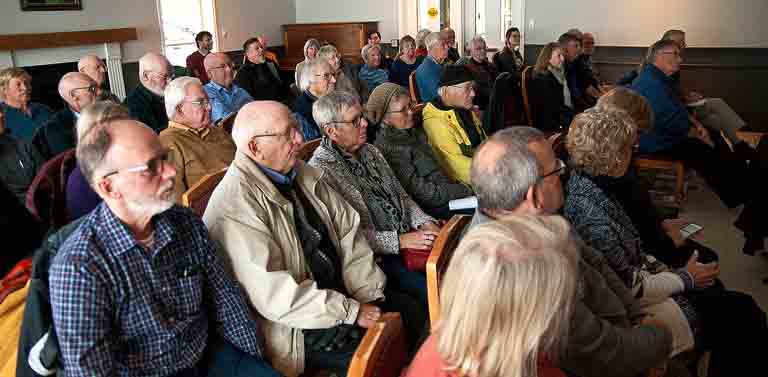
This point drew the most comments for the full house for the first afternoon session, and for the second evening session. There were a few former and current board members from OMAH at the afternoon session, and a large number of OMAH supporters at the evening session – which I did not attend, but inquired about.
The report did not provide the ammunition for those who want a full scale merger. It did show there a number of areas Leacock and OMAH can work together, and I think this is the right conclusion.
First, a full merger is like mashing humans and birds together because we share some DNA. Yes they are both museums, but they do not have similar purpose, nor, as was pointed out to me, serve the same audience.
OMAH has done incredible things the last 4 or 5 years and they have a very strong organization with great financing, programming and reputation. They are however, local in scope. Leacock on the other hand has been starved for attention by City Hall ever since the volunteer and highly capable management board and the Culture Department were disbanded.
Sure the City spent a lot on upkeep, and on the ugliest wheel chair ramp to deface a national monument, but things like visitor generating programming has been stagnating, which is with inflation accounted like choking it to the point of passing out. Had there been the same kind of attention and a vital management as OMAH I’m sure the exercise of a study and hand wringing about what to do with the Leacock Museum would not be a thing today.
Here’s another example of budgetary neglect over time. The consultants found the museum is understaffed, even for the stripped down operation it has become, so among the recommendations is hiring some staff. Not just any staff, but those who have expertise in the areas recommended the City undertake to restore the museum operation to a level it used to have. The consultant believes money spent in the right places will increase attendance and new income will offset expenses eventually.
With a ten year plan of short, medium and long-term goals, another recommendation is for council to undertake some capital improvements ranging from altering the layout of Swanmore Hall to some repurposing and renovation of the house to create better function and exhibit space to the tune of $800,000. A lot of people balked at that, but I think if attention had been paid all along the way, the need to spend that much money in a short period of time to revitalize things would be unnecessary.
In recommending a partnership with OMAH, Linton was clear he did not mean a management arrangement. There are a number of functions like marketing which if combined would make sense. Creating some joint exhibitions and having both volunteer groups work together are also good ideas. OMAH has been working those particular areas very well lately.
There is one more painless recommendation to initiate and very important at the same time. It is to create a board. There was a board once and the people on it were all established and successful business people. Council didn’t listen to them, and eventually disbanded the board, and in my opinion hindsight proved the board was right. The action they advocated would have transformed the museum into a national and international treasure and not doing anything would lead to decay and diminishment of the museum in the face of competing interests. The former is hard to prove, but the latter is where we are at today.
The City should recruit a board made of people with the skills to guide the organization and staff toward agreed upon goals, if council agrees with the goals of the master plan. No offence to previous board members of the library, but changing the makeup of the library board from a nice group of book lovers and readers to recruiting those with skills in the areas needed to improve the library’s situation and construct a new library worked pretty well. The Leacock Museum needs a similar board.
Focus People, Focus
Another important recommendation is expanding the scope of how to position Leacock. Linton said Leacock was really Canada’s first renaissance figure in Canadian history. He was more than a humourist and those things should be brought to the fore. This is not a new idea. Fred Addis started on this track when he was curator of the museum. However, not supporting the program financially with an eye to growth derailed that notion.
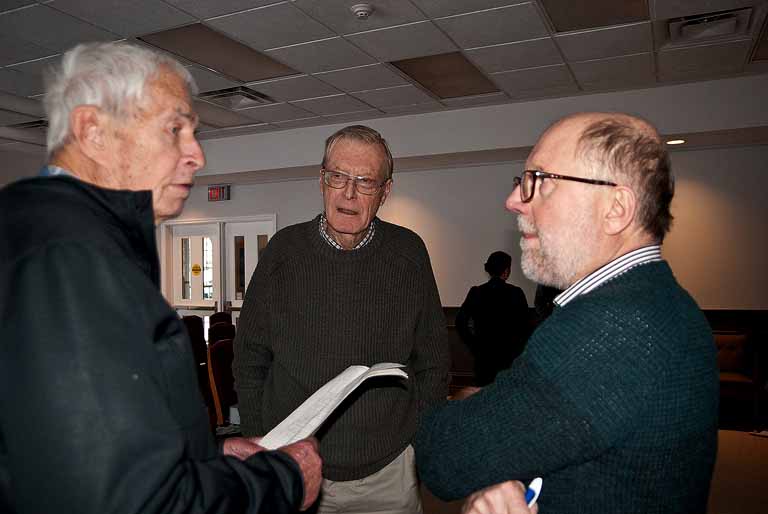
Linton also touched on expanding events. He said his team found them well run, but for various reasons weren’t reaching audiences. Again, if there is a limited marketing budget, you get crickets. He said a key to increasing interest in Leacock and the museum is reaching people and teaching people. I agree. What I found lacking is the very idea I started this column with.
We have an example working right now of what hooking children can do and that is our library. In the late 90s a report to the board outlined a year’s long decline in circulation and visitors to the library. There were a number of factors like a building that just wasn’t working anymore. One thing that happened at that board meeting at the urging of one particular board member (yeah, it was me), was to start a plan to increase the amount of children’s programming. There was children’s programming, but I recall a week’s worth of programming back then is less than any single day’s children’s programming available this week.
The theory taken from life experience is we lost a generation or two of people who regard the library as essential to the community, but not necessarily to themselves and to regain you have to hook children. Creating familiarity and love of any interest with kids breeds a new generation of regular users, which amped up programming did in spades. The side benefit, and unforeseen, was parents of those children became heavy users of the library too. Wins all around.
I believe it is necessary to get Leacock back on the school curriculum. It’s a long haul objective because those who run the education system don’t listen to outsiders very well (they try to give the appearance, new school anyone?). In the mean time The City needs to give the museum support to initiate on-site and outreach programming for children and teens to rebuild capacity and then use built capacity to browbeat school administrators, at least locally for a start, to have kids read the best writing available, which is Leacock’s. They don’t have to end at Leacock, but he would be a good start.
We can be instrumental building a generation of readers, writers and thinkers who will become visitors, supporters and participants in programs of the Leacock Museum. Ten, fifteen, twenty years from now the Leacock Museum can truly be a National Historic Site in more than name. It starts with council accepting in principal the recommendations in the proposed master plan.
![]()



![]()
The Shorts
* The Maple Blues Awards happened Monday night and Lance Anderson lost producer of the year to Dawn Tyler Watson and the band he organized, Matchedash Parish, lost new artist of the year to Miss Emily. Here’s a list of other winners who have played in Orillia in the last two years: Downchild Blues Band, Matt Andersen, Michael Fonfara (Lifetime Achievement), Paul Des Lauriers, Jesse O’ Brien, Chris Whiteley, and Alec McElcheran. Fifteen of the nominees have been on a stage here as well. We do alright when it comes to getting top musicians in town to play. David Vest and Steve Marriner were also nominated and we get to see them Saturday night when they play the Mariposa Folk Festival’s Lance Anderson production of the 9th Gospel and Blues gig (sold out).
* The Artrepreneur program the city and the county ran for the last 4 months is going public. A number of artists signed up for the 13 week program designed to help them learn about the business side of running their art careers. The program is over and its show and tell time with a showcase at the Opera House Thursday at 6:30 p.m.

* OMAH has the grand opening Saturday from 1 to 3 p.m. of the annual International Women’s Day Art Show. This is the exhibit which draws the most people on opening day, so it’s extra fun. Sunday Feb. 23 Storytelling Orillia’s monthly, 2 to 4 p.m., has guests who have work in the Women’s show. Other exhibits are She Shoots… She Scores and it’s about women’s hockey, coinciding with the Ontario Winter Games here in Orillia and Tracey Lawko’s At Risk, which also opens Saturday. Feb. 19 is history speaker’s night (7:30 p.m.) and the guest is the Simcoe County Historical Association’s Andrew Hunter Award winner, John Merritt, who was recognized for his paper on the Black Settlement in Oro Township.
* Hibernation Arts has a group show, Love, opening Saturday at 1 p.m.; they also have Bryan McPherson in for the March 26 gallery concert. The boss is calling dibs on the first exhibit of the year at Lee Contemporary Art; Tanya Cunnington’s From Sudbury to Sointula will be up for three days starting today.
* The Orillia Centre for Arts and Culture has an event, Artists Talk, Feb. 22 from 2 to 4 p.m. at the Opera House. Speakers are Will McGarvey (painter), Heidi Strauss (dance), Luke Garwood (dancer/multi-disciplinary), and Zachary Lucky (musician). Also on board are emerging artists Lauren Cookson, Leo Martyn, Veda Shapre and Bayze Murray. Get tickets at the Opera House box office.
* A group of people have been working on establishing the Orillia Tool Library and Makerspace. The goal is to have available the heavier kinds of tools (what artists call the dirty arts like woodworking and welding as opposed to painting and well, painting). They have an online survey you can take.
* Jim Harris is booking musicians for the Farmers’ Market 2020 season. Shoot him an email to jimharris@vianet.ca .
* The Opera House has Mariposa Arts Theatre’s The Art of Dining opening Feb. 13. Murray McLauchlan plays Feb. 19. Get tickets online.
* The County of Simcoe is receiving applications for the 2020 Tourism, Culture and Sport Grant Program. It’s open to municipalities and not-for-profits. You have until Feb. 28 to apply for a share of the $300,000 fund. You can find details here.
* The Washago Lions Club is planning Canada Day now and would like to hear from vendors, people who can volunteer day of (or before) and musicians. Email Doug Shakell at dougieo40@hotmail.com. And, the monthly jam night happens Feb. 19 at the club hall.
* Coming up… the Hog ‘N Penny has trivia night with Bill Dunlop every Thursday evening; Sean Patrick and the Davis Family Singers play Friday night; Jakob Pearce is in Saturday… the Brownstone has an Open Mic Night every Tuesday; Zachary Lucky is playing Feb. 22 and you might want to get tickets in advance for this one… … The Jazz Byrds play Sanafir every Saturday evening… MAT’s next film night at the Galaxy is Feb. 19 with The Peanut Butter Falcon (Shia LaBeouf, Dakota Johnson) at 4 and 7 p.m. … Ashley Mac Isaac is playing at St. Paul’s Centre March 17 (Hmmm, there’s something about that date) and you can get tickets here… the Jubilee Chorale’s annual Sweet Heart soiree is Feb. 23 at 2:30 p.m. at St. Paul’s Centre; this fundraiser for Helping Hands is a give-what-you-can admission; they a have a number of guests including Jim Harris and Blair Bailey.
(Photos by Swartz – SUNonline/Orillia; Submitted) Main: Attendees at the Leacock Museum Master Plan draft presentation.

